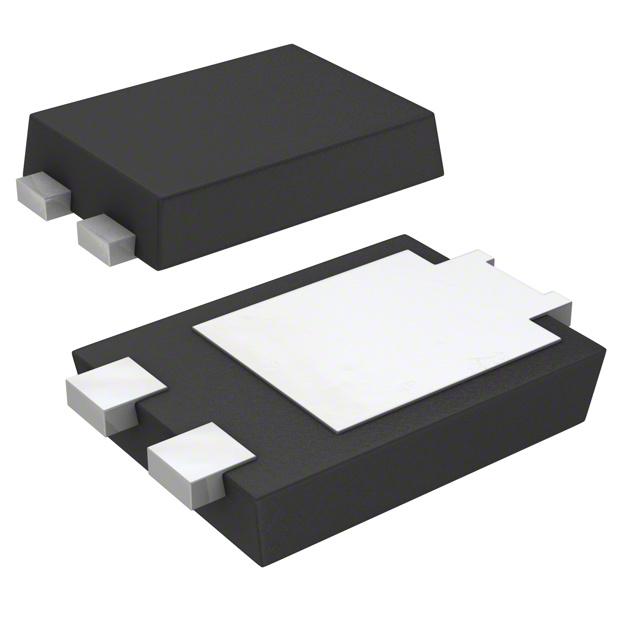SBR8U300P5-13: Product Overview and Analysis
Introduction
The SBR8U300P5-13 is a semiconductor product that belongs to the category of Schottky Barrier Rectifiers. This entry provides an overview of the basic information, specifications, pin configuration, functional features, advantages and disadvantages, working principles, application field plans, and alternative models of the SBR8U300P5-13.
Basic Information Overview
- Category: Schottky Barrier Rectifiers
- Use: The SBR8U300P5-13 is used as a rectifier in various electronic circuits and power supply applications.
- Characteristics: It exhibits low forward voltage drop, high-frequency operation capability, and fast switching speed.
- Package: The SBR8U300P5-13 is typically available in a TO-220AB package.
- Essence: It serves as a crucial component in power conversion and rectification circuits.
- Packaging/Quantity: The product is commonly packaged in reels or tubes, with quantities varying based on manufacturer specifications.
Specifications
The detailed specifications of the SBR8U300P5-13 include: - Forward Voltage: 0.65V - Reverse Voltage: 300V - Average Rectified Current: 8A - Maximum Operating Temperature: 150°C - Reverse Recovery Time: 35ns
Detailed Pin Configuration
The SBR8U300P5-13 typically features a standard pin configuration for its TO-220AB package, with the anode and cathode connections clearly labeled for easy integration into circuit designs.
Functional Features
- Low forward voltage drop ensures minimal power loss during operation.
- High-frequency operation capability enables efficient performance in switching applications.
- Fast reverse recovery time contributes to improved circuit efficiency.
Advantages and Disadvantages
Advantages
- Efficient power conversion due to low forward voltage drop.
- Suitable for high-frequency applications.
- Fast switching speed enhances overall circuit performance.
Disadvantages
- Higher cost compared to standard rectifier diodes.
- Limited availability of alternative models from different manufacturers.
Working Principles
The SBR8U300P5-13 operates based on the Schottky barrier principle, where the metal-semiconductor junction allows for fast switching and low forward voltage drop characteristics. During forward bias, the rectifier efficiently conducts current with minimal voltage drop, making it ideal for power conversion applications.
Detailed Application Field Plans
The SBR8U300P5-13 finds extensive use in the following application fields: - Switching power supplies - DC-DC converters - Inverters - Motor drives - Solar power systems
Detailed and Complete Alternative Models
While the SBR8U300P5-13 is a widely used Schottky Barrier Rectifier, alternative models from different manufacturers include: - STMicroelectronics STPS8H100D - Vishay VS-8EWF06SPBF - ON Semiconductor MBRB20100CTG
In conclusion, the SBR8U300P5-13 is a vital component in modern power electronics, offering efficient rectification and fast switching capabilities. Its application spans across various industries, making it a key player in power conversion and control circuits.
[Word Count: 413]
Senaraikan 10 soalan dan jawapan biasa yang berkaitan dengan aplikasi SBR8U300P5-13 dalam penyelesaian teknikal
What is the SBR8U300P5-13 used for in technical solutions?
- The SBR8U300P5-13 is a Schottky barrier rectifier diode commonly used for power supply, voltage clamping, and reverse polarity protection in various technical solutions.
What are the key specifications of the SBR8U300P5-13?
- The SBR8U300P5-13 has a maximum repetitive peak reverse voltage of 300V, a forward current of 8A, and a low forward voltage drop.
How does the SBR8U300P5-13 compare to other similar diodes in technical applications?
- The SBR8U300P5-13 offers lower forward voltage drop and faster switching compared to traditional PN junction diodes, making it suitable for high-frequency applications.
Can the SBR8U300P5-13 be used in automotive electronics?
- Yes, the SBR8U300P5-13 is suitable for automotive electronics due to its high reliability and robustness.
What are the thermal considerations when using the SBR8U300P5-13 in technical solutions?
- Proper heat sinking and thermal management are important to ensure the SBR8U300P5-13 operates within its specified temperature range for optimal performance and longevity.
Are there any application notes or reference designs available for the SBR8U300P5-13?
- Yes, manufacturers often provide application notes and reference designs to assist engineers in implementing the SBR8U300P5-13 in various technical solutions.
Can the SBR8U300P5-13 be used in high-power applications?
- Yes, the SBR8U300P5-13 is capable of handling high currents and is suitable for high-power applications such as power supplies and motor drives.
What are the typical failure modes of the SBR8U300P5-13 in technical solutions?
- Common failure modes include thermal overstress, reverse voltage breakdown, and excessive forward current leading to junction failure.
Does the SBR8U300P5-13 require any special handling during assembly or soldering?
- It is important to follow the manufacturer's recommended handling and soldering guidelines to prevent damage to the SBR8U300P5-13 during assembly.
Where can I find reliable sources for purchasing the SBR8U300P5-13 for my technical solutions?
- Authorized distributors and reputable electronic component suppliers are reliable sources for purchasing the SBR8U300P5-13 for your technical solutions.


